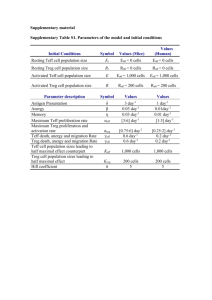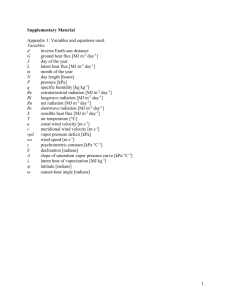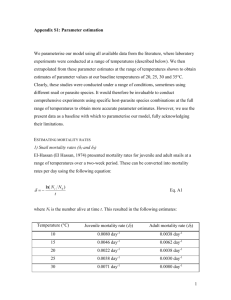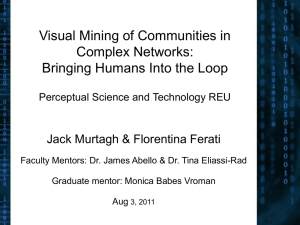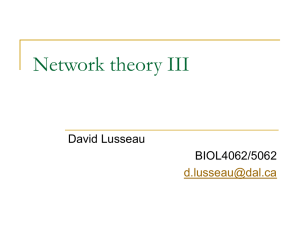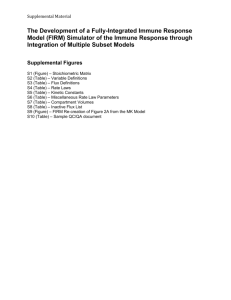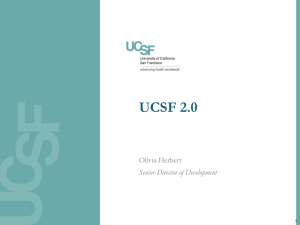+ Evolutionary game theory for biologists
advertisement
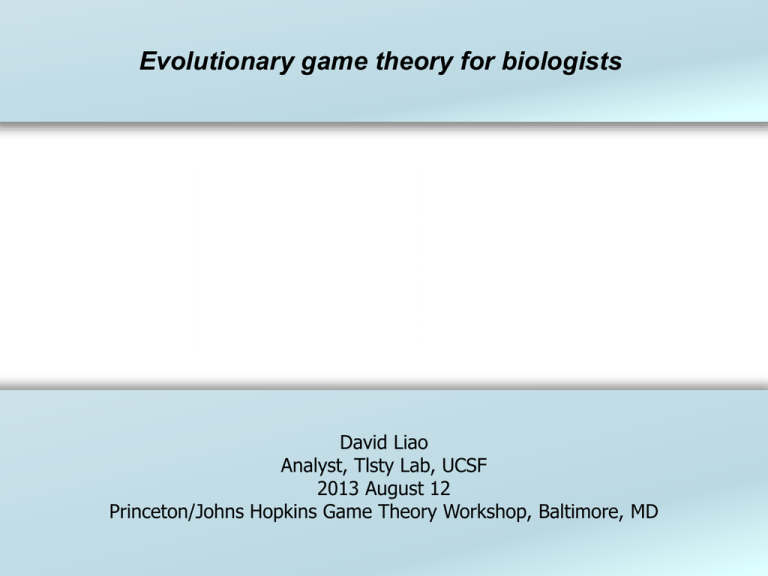
Evolutionary game theory for biologists Population dynamics Manual data analysis Epicycles Modularity + David Liao Analyst, Tlsty Lab, UCSF 2013 August 12 Princeton/Johns Hopkins Game Theory Workshop, Baltimore, MD Basic model with pairwise interactions Population dynamics 𝑑𝐶 = 𝑅𝑝𝐶 + 𝑆𝑝𝐷 𝐶 𝑑𝑡 𝐶 𝑝𝐶 = 𝐶+𝐷 𝑑𝐷 = 𝑇𝑝𝐶 + 𝑃𝑝𝐷 𝐷 𝑑𝑡 𝑝𝐷 = 𝐷 𝐶+𝐷 Note: Using labels C, D, T, R, P, and S does not, itself, logically imply that this model be a “prisoner’s dilemma” 2 Evolutionary game theory for biologists Population dynamics Manual data analysis Epicycles Modularity + David Liao Analyst, Tlsty Lab, UCSF 2013 August 12 Princeton/Johns Hopkins Game Theory Workshop, Baltimore, MD Back-of-the-envelope data analysis 4 Back-of-the-envelope data analysis 5 Estimating rate coefficient from initial slope (a) Estimate the parameters T, R, P, and S. Express your answers in units of day-1. T = 0.5 day-1; R = 0.25 day-1; 𝑑𝐶 = 𝑅𝑝𝐶 + 𝑆𝑝𝐷 𝐶 𝑑𝑡 P = -0.25 day-1; S = -0.5 day-1 Seeded 10,000 copper cells and only 100 denim cells +5000 cells 𝑑𝐶 ≈ 𝑅𝐶 (if pC ~ 1) 𝑑𝑡 1 ∆𝐶 ≈𝑅 𝐶 ∆𝑡 +2 days 𝑅≈ 1 +5000 cells 10,000 cells +2 days 1 = day −1 4 6 Using a model to fill in a phase plane (b) Draw quivers on the provided sheet of graph paper to approximate how much the copper and denim subpopulations would change over the course of a day, starting from various initial subpopulation sizes. Start from C = D = 2000, find population change over a day? 𝑑𝐶 𝑑𝐶 = 𝑅𝑝𝐶 + 𝑆𝑝𝐷 𝐶 ∆𝐶 ≈ ∆𝑡 𝑑𝑡 𝑑𝑡 ∆𝐶 ≈ 0.25 day −1 0.5 + −0.5 day −1 0.5 2000 cells 1 day ∆𝐶 ≈ −250 cells 𝑑𝐷 ∆𝐷 ≈ ∆𝑡 𝑑𝑡 ∆𝐷 ≈ 𝑑𝐷 = 𝑇𝑝𝐶 + 𝑃𝑝𝐷 𝐷 𝑑𝑡 0. 5 day −1 0.5 + −0.25 day −1 0.5 2000 cells 1 day ∆𝐷 ≈ +250 cells T = 0.5 day-1; R = 0.25 day-1; P = -0.25 day-1; S = -0.5 day-1 7 Using a model to fill in a phase plane (b) Draw quivers on the provided sheet of graph paper to approximate how much the copper and denim subpopulations would change over the course of a day, starting from various initial subpopulation sizes. From C = D = 2000, 𝑑𝐶 ∆𝐶 ≈ ∆𝑡 𝑑𝑡 𝑑𝐶 = 𝑅𝑝𝐶 + 𝑆𝑝𝐷 𝐶 𝑑𝑡 ∆𝐶 ≈ −250 cells 𝑑𝐷 ∆𝐷 ≈ ∆𝑡 𝑑𝑡 𝑑𝐷 = 𝑇𝑝𝐶 + 𝑃𝑝𝐷 𝐷 𝑑𝑡 ∆𝐷 ≈ +250 cells T = 0.5 day-1; R = 0.25 day-1; P = -0.25 day-1; S = -0.5 day-1 8 Using a model to fill in a phase plane (b) Draw quivers on the provided sheet of graph paper to approximate how much the copper and denim subpopulations would change over the course of a day, starting from various initial subpopulation sizes. From C = D = 2000, 𝑑𝐶 ∆𝐶 ≈ ∆𝑡 𝑑𝑡 𝑑𝐶 = 𝑅𝑝𝐶 + 𝑆𝑝𝐷 𝐶 𝑑𝑡 ∆𝐶 ≈ −250 cells 𝑑𝐷 ∆𝐷 ≈ ∆𝑡 𝑑𝑡 𝑑𝐷 = 𝑇𝑝𝐶 + 𝑃𝑝𝐷 𝐷 𝑑𝑡 ∆𝐷 ≈ +250 cells T = 0.5 day-1; R = 0.25 day-1; P = -0.25 day-1; S = -0.5 day-1 9 Back-of-the-envelope data analysis 10 Validating model using phase path (c) Represent the data from container III as a phase path in the phase plane you have just sketched. Is the trajectory consistent with the quiver field in direction and magnitude? 11 Back-of-the-envelope data analysis Recently, ideas about complexity, self-organization, and emergence--when the whole is than the sum of its A mixture ofgreater cell subpopulations proliferates with Momentum isparts--have conserved come into fashion as alternatives for metaphors fitnesses linearly dependent on population composition of control. But such explanations offer only smoke and mirrors, functioning merely to provide names for what we can't explain; they elicit for me the same dissatisfaction I feel when a physicist says that a particle's behavior is caused by the equivalence of two terms in an equation. . . . The hope that general principles will explain the regulation of all the diverse complex dynamical systems that we find in nature can lead to ignoring anything that doesn't fit a pre-existing model. When we learn more about the specifics of such systems, we will see where analogies between them are useful and where they break down. --Deborah Gordon (2007) Control without hierarchy. Nature 446: 143 12 Evolutionary game theory for biologists Population dynamics Manual data analysis Epicycles Modularity + David Liao Analyst, Tlsty Lab, UCSF 2013 August 12 Princeton/Johns Hopkins Game Theory Workshop, Baltimore, MD Mass action, Taylor series, and epicycles Population dynamics 𝑑𝐶 = 𝑅𝑝𝐶 + 𝑆𝑝𝐷 𝐶 𝑑𝑡 Pairwise collisions 3-way collisions ≥ 4-way 𝑑𝐶 = 𝑅𝑝𝐶 + 𝑆𝑝𝐷 + 𝐴𝐶𝐶 𝑝𝐶2 + 𝐴𝐶𝐷 𝑝𝐶 𝑝𝐷 + 𝐴𝐷𝐷 𝑝𝐷2 + ⋯ 𝐶 𝑑𝑡 Power-series for generic analytic function 14 Evolutionary game theory for biologists Population dynamics Manual data analysis Epicycles Modularity + David Liao Analyst, Tlsty Lab, UCSF 2013 August 12 Princeton/Johns Hopkins Game Theory Workshop, Baltimore, MD How complicated must our model be? Intracellular 2 cell subpopulations 3 cell subpopulations ... Mouse sketch file (and CC BY SA license information) at commons.wikimedia.org/wiki/File:Vectorized_lab_mouse_mg_3263_for_scientific_figures_and_presentations.svg Patient 16 Modularity ≠ ≈ Sophisticated computation Fault containment, revision How does time-varying environment in which life evolves determine scale(s) at which and mechanisms by which a system is integrated and/or segregated? Given risks and economics, should compartments be tightly connected or well isolated? Keep water out Burn coal Power engine Turn propellers 17 Evolutionary game theory for biologists Population dynamics Manual data analysis Epicycles Modularity + David Liao Analyst, Tlsty Lab, UCSF 2013 August 12 Princeton/Johns Hopkins Game Theory Workshop, Baltimore, MD Questions + 𝑑𝐶 = 𝑅𝑝𝐶 + 𝑆𝑝𝐷 𝐶 𝑑𝑡 𝑑𝐷 = 𝑇𝑝𝐶 + 𝑃𝑝𝐷 𝐷 𝑑𝑡 𝑑𝑥𝑖 = 𝑓 𝑥𝑖 + 𝜂𝑖 (𝑡) 𝑑𝑡 Why doesn’t origin look like a saddle? Mechanisms Direct contact Indirect contact: Short-lived soluble factor This validation of a mutation-free model also validates model with mutation Compare results from 2-, 3-, 4-subpopulation experiments to infer modularity? Motifs vs. modules Kashtan & Alon 2005 Huang & Kauffman 2013 Acknowledgments NIH/NCI U54CA143803 (Austin) Thea Tlsty/Tlsty Lab Validation of mutation-free model consistent with social mutation + 𝑑𝐶 = 𝑅𝑝𝐶 + 𝑆𝑝𝐷 𝐶 𝑑𝑡 𝑑𝐷 = 𝑇𝑝𝐶 + 𝑃𝑝𝐷 𝐷 𝑑𝑡 +𝑇𝑝𝐷 𝐶 In this example, S = -T Two inconsistent mechanisms can be validated by one dataset because 𝑑𝐶 mechanisms can generate the same 𝑑𝐷 governing equations. 𝐶 inconsistent = 𝑅𝑝𝐶 𝐶 − 𝑇𝑝𝐷 𝐶 = 𝑃𝑝𝐷 𝐷 + 𝑇 𝐷 Empirically validated = not yet rejected𝑑𝑡≠ proved to be true 𝑑𝑡 𝐶+𝐷 Let T = k1 – k2 𝑑𝐶 = 𝑅𝑝𝐶 𝐶 − 𝑘1 𝑝𝐷 𝐶 + 𝑘2 𝑝𝐷 𝐶 𝑑𝑡 𝑑𝐶 𝐷 = 𝑅𝑝𝐶 𝐶 − 𝑘1 𝑝𝐷 𝐶 + 𝑘2 𝐶 𝑑𝑡 𝐶+𝐷 +𝑘2 𝑝𝐶 𝐷 Socially modulated mutation 𝑑𝐶 = 𝑅𝑝𝐶 𝐶 − 𝑘1 𝑝𝐷 𝐶 + 𝑘2 𝑝𝐶 𝐷 𝑑𝑡 𝑑𝐷 = 𝑃𝑝𝐷 𝐷 + 𝑘1 𝑝𝐷 𝐶 − 𝑘2 𝑝𝐶 𝐷 𝑑𝑡
